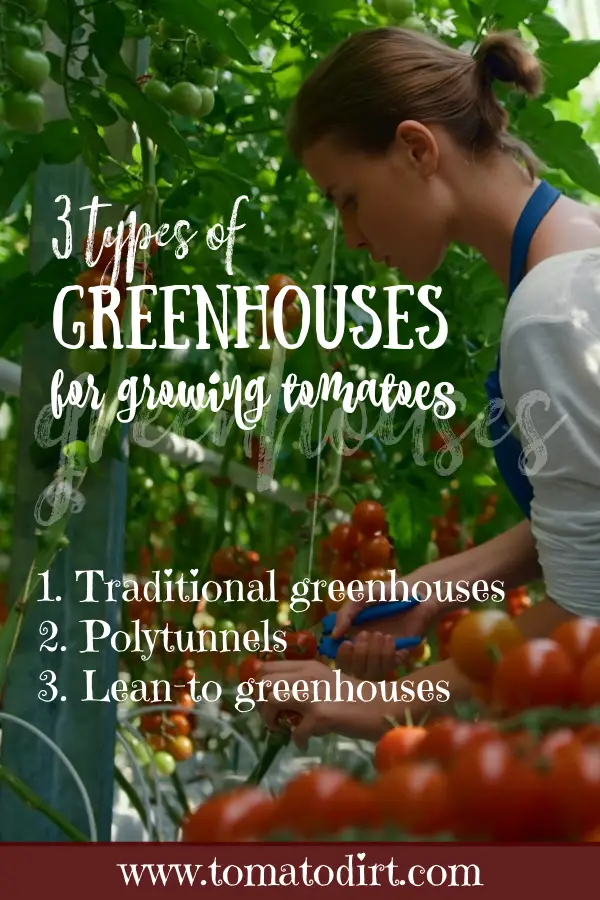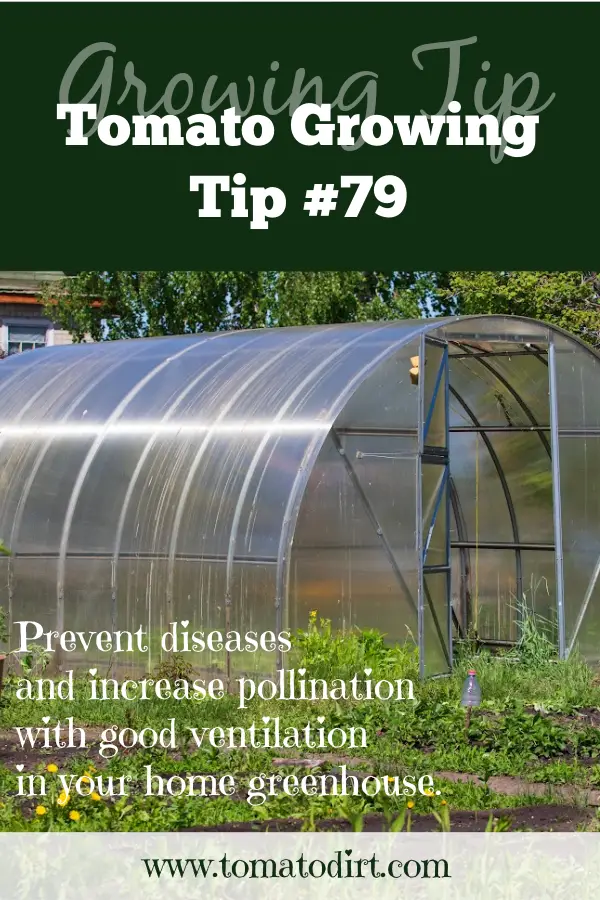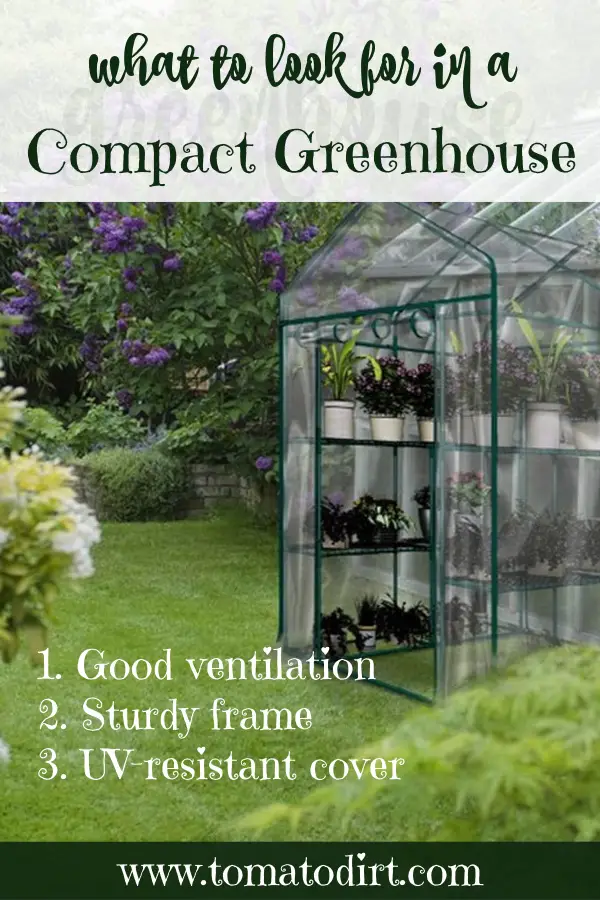FREE: 10 Must-Know Tomato Growing Tips Get The Guide
Read our affiliate disclosure here.
Can I grow tomatoes in a greenhouse? FAQs and tips
Since 2010, Tomato Dirt has garnered 4.8+ million views, making it the web’s leading online source for growing tomatoes in the home garden. Award-winning writer and Tomato Dirt owner Kathy Widenhouse has helped thousands of home gardeners grow healthier tomatoes. Be one of them when you get Tomato Dirt’s Growing Guide here.
Updated 10.28.25
When you grow tomatoes in a greenhouse, you can extend the growing season. You can have fresh tomatoes all year long.
Plus, if you use a greenhouse (even a small hobby version), you can start tomato seedlings early and be ready to set them outside as soon as the threat of frost has passed. This way, your seedlings get a jumpstart on the season and can yield you a bumper crop.
But back to growing tomatoes in a greenhouse when the rest of your landscape is dreary and cold.
Q. Why grow tomatoes in a greenhouse?
- You’ll have an extended growing season. A greenhouse provides a controlled environment, allowing gardeners to extend the growing season beyond the limitations of outdoor conditions. This is particularly beneficial for tomatoes, which thrive in warm temperatures.
- You can regulate temperatures. Tomatoes require specific temperature range to thrive: at least 50F overnight and up to 90F during the day. You can’t control Mother Nature. But you can use fans, vents, wet walls, shade cloths, misting, and radiant heat to control temperatures inside your greenhouse.
- You can regulate humidity. Tomato plants produce best with humidity levels between 65-75% overnight and 80-90% during the day. Too much humidity can significantly reduce plants’ yields in a greenhouse, causing the plants to expend extra energy in absorbing nutrients. On the other hand, not enough humidity can cause your plants to dry out, require more water, and fight to survive. You monitor humidity in your greenhouse with a psychrometer, and you can ventilate, dehumidify, or moisten the environment as needed.
- You can protect plants from extremes. Greenhouses act as a shield against adverse weather conditions such as frost, heavy rain, and strong winds during the cold season – as well as drought and excess heat in the summer. This protection is crucial for tomatoes, which are sensitive to sudden temperature changes.
- You can control pests. A greenhouse provides a natural barrier between your tomato plants and creepy-crawlies.
- You can limit diseases. A well-maintained greenhouse offers healthy circulation and consistent watering, which minimizes the conditions in which tomato blight and tomato funguses flourish.
Q. What types of greenhouses are best for growing tomatoes?
Traditional greenhouses
These structures are made of glass or polycarbonate panels and provide a controlled environment for tomatoes. Traditional greenhouses come in various sizes, so you can choose one that fits your space, your needs, and your budget.
Polytunnels
A cost-effective alternative to traditional greenhouses, polytunnels is a steel frame covered by polyethylene or a similar material. Polytunnels are available or can be built in all sizes. They are easy to set up and provide protection while allowing for natural sunlight to reach the plants.
Lean-to greenhouses
Lean-to greenhouses are attached to an existing structure, like the side of your house or garage. They are space-efficient and can be a practical option for home gardeners with limited space.
Q. What are the most common problems I'll fce when I grow tomatoes in a greenhouse?
- Ventilation. Greenhouses need proper air circulation to prevent the buildup of excess heat and humidity. Inadequate ventilation can allow fungal diseases to flourish when spores settle in for the long haul. And without good air circulation, plants can struggle to pollinate which leads to low fruit set.
- Diseases. While greenhouses offer protection from some diseases, they can also create a favorable environment for pathogens like powdery mildew.
- Pollination. Natural pollinators like insects, birds, and breezes are limited in a greenhouse. You may need to manually pollinate your greenhouse tomato plants with shaking or brushing.
Q. Will tomatoes grow faster in a greenhouse?
The growth rate of tomatoes in a greenhouse compared to open-field cultivation varies, depending on based on several factors: environmental conditions, tomato plant care, and greenhouse technology. While there isn't a one-size-fits-all answer, some studies and facts shed light on the potential advantages of greenhouse cultivation for accelerating tomato growth.
- Temperature control. Greenhouses provide a controlled environment with the ability to regulate temperature. According to a study published in the Journal of Agricultural Science and Technology (2014), tomatoes generally exhibit faster growth rates when exposed to optimal temperatures. Greenhouses allow growers to maintain ideal temperature conditions, which promotes faster germination, flowering, and fruit development.
- Extended growing season. A study conducted by the University of Florida Extension found that tomatoes grown in greenhouses have an extended growing season compared to those grown outdoors. Greenhouses protect plants from extreme weather conditions, allowing for a longer period of active growth and fruit production.
- Higher CO2 levels. Greenhouses often have higher concentrations of carbon dioxide (CO2) than what’s measured in open fields. Elevated CO2 levels can enhance photosynthesis, which promotes faster growth and increased yields. A study published in HortScience (2015) indicates that increased CO2 levels in greenhouses positively influence tomato growth and fruit quality.
- Protection. Greenhouses offer a protective barrier against pests and diseases. That translates to healthier, less stressed plants, leading to faster and more vigorous growth. Research from the International Journal of Pest Management suggests that reduced pest pressure in greenhouses positively impacts tomato growth.
Q. What is a good small greenhouse for tomatoes?
Several compact and affordable greenhouse options are available to home gardeners. Be sure to examine each model’s features like good ventilation, sturdy frames, and UV-resistant covers to ensure your greenhouse’s durability and effectiveness. But also consider your garden space, your climate, and your budget when choosing your small greenhouse for tomatoes and other garden vegetables.
Palram Nature Series Mythos Hobby Greenhouse
Size: Available in various sizes (6x4, 6x6, 6x8)
Features: Polycarbonate panels, rust-resistant aluminum frame, roof vent for ventilation, galvanized steel base.
Reasons: Compact design, easy to assemble, and provides a controlled environment for tomato cultivation.
Quictent Portable Greenhouse
Size: Available in various sizes (6x3, 8x6, 12x7)
Features: Powder-coated steel frame, transparent PVC cover, roll-up zippered door, adjustable ventilation.
Reasons: Affordable, portable, and suitable for small spaces. Easy to set up and move if needed.
Outsunny Walk-in Polycarbonate Greenhouse
Size: Available in various sizes (6x6, 6x8, 6x10)
Features: Twin-wall polycarbonate panels, rust-resistant aluminum frame, sliding door, roof vent.
Reasons: Provides a stable and insulated environment for plants. Easy access with a sliding door.
Flower House Pop-Up Plant House
Size: Compact sizes available.
Features: Pop-up design, clear PVC cover, zippered door, ground stakes.
Reasons: Extremely portable and easy to set up. Suitable for small gardens or temporary use.
Gardman R687 4-Tier Mini Greenhouse
Size: Compact size with four shelves.
Features: Tubular steel frame, clear polyethylene cover, roll-up zippered door.
Reasons: Space-saving vertical design, ideal for balconies or small patios. Provides protection for young plants.
Best Choice Products 15x7x7ft Walk-in Greenhouse
Size: Walk-in design with ample space.
Features: Powder-coated steel frame, transparent PVC cover, roll-up zippered door, six roll-up windows.
Reasons: Offers more space for larger tomato plants. Good ventilation options.
Q. What are the best greenhouse tomato varieties?
To successfully grow tomatoes in a greenhouse year-round, choose varieties that can thrive in controlled environments and are adaptable to changing light and temperature conditions. These greenhouse tomato varieties are known for their suitability for year-round cultivation.
Tomimaru Muchoo (Japanese Cherry Tomato)
Characteristics: Small, sweet cherry tomatoes.
Reasons: Well-adapted to greenhouse growing, high yield, and suitable for year-round production.
Kakapo F1
Characteristics: Medium-sized, round tomatoes.
Reasons: Specifically bred for greenhouse cultivation, disease-resistant, and known for consistent yield.
Balbina F1
Characteristics: Oval-shaped, medium-sized tomatoes.
Reasons: High yield, disease-resistant, and well-suited for greenhouse conditions, including year-round cultivation.
De Ruiter's Merlice
Characteristics: Medium to large-sized tomatoes.
Reasons: Known for adaptability to greenhouse environments, disease resistance, and continuous production.
Geronimo F1
Characteristics: Large, round tomatoes.
Reasons: High-yielding, disease-resistant, and suitable for year-round greenhouse production.
Sakura F1
Characteristics: Small, round, red cherry tomatoes.
Reasons: Developed for greenhouse cultivation, early maturity, and continuous fruiting.
Multifort F1
Characteristics: Medium-sized tomatoes.
Reasons: Disease-resistant, suitable for greenhouse growing, and known for consistent yield.
San Marzano 2.0
Characteristics: Plum tomatoes with a classic San Marzano shape.
Reasons: Well-suited for greenhouse cultivation, disease-resistant, and ideal for sauces and processing.
Artisan Tomatoes (Various Colors)
Characteristics: Small to medium-sized tomatoes in various colors.
Reasons: Artisan varieties, such as Artisan Pink Bumblebee or Artisan Blush Tiger, are often well-adapted to greenhouse conditions and offer unique flavors.
Allegro F1
Characteristics: Medium-sized, round tomatoes.
Reasons: Known for high yield, disease resistance, and suitability for greenhouse cultivation throughout the year.
Q. Can I grow tomatoes in a greenhouse from seeds?
Growing tomatoes from seeds in a greenhouse is much like starting seeds indoors. Follow this step-by-step guide.
- Choose your tomato variety. Select tomato varieties that suit your taste, but also consider your growing conditions – particularly if you plan to transplant the seedlings outdoors.
- Gather seed starting supplies. You’ll need seed trays, seed starting mix, labels, watering can, and any optional equipment like a heat mat or grow lights.
- Fill seed trays or pots. Use a wheelbarrow or large bucket to prepare your seed starting mix. Add water and mix so that the soil will hold its shape when you squeeze it into a ball – but won’t drip excess. Fill your containers with the soil and pack down slightly, leaving about ½ inch to the top.
- Plant the tomato seeds. Plant 2-3 seeds per cell or pot, burying them about 1/4 to 1/2 inch deep. Space the seeds according to the recommended distance for your chosen variety. Press down the top of the soil lightly.
- Label the containers. Place labels in each tray or pot to identify the type of tomato and planting date. This way you can keep track of different varieties and their growth stages.
- Water seed trays. Water the trays or pots thoroughly after planting. Ensure the soil is evenly moist but not waterlogged. Use a watering can or a spray bottle for gentle watering.
- Cover the containers. Cover the seed trays with a plastic dome or loosely with plastic wrap to create a humid environment that promotes germination. This helps retain moisture and warmth.
- Provide heat. The ideal temperature for growing greenhouse tomatoes is 65F-85F. If your greenhouse temperature is on the cooler side, consider placing the seed trays on a heat mat to provide bottom heat, encouraging faster and more uniform germination. On the other hand, some greenhouses are so effective that interior temperatures can exceed on sunny days. Keep a thermometer hanging in your greenhouse so you can monitor for optimum temperature conditions.
- Monitor germination. Check the trays each day Once seedlings emerge, remove the plastic dome or wrap to allow proper air circulation.
- Provide adequate light. Place the trays in a location where they receive ample sunlight. If natural sunlight is insufficient, consider using supplemental grow lights to provide the necessary light for healthy seedling growth.
- Transplant seedlings. Once the seedlings have developed their first set of true leaves, transplant them into larger pots or directly into the greenhouse soil. Ensure proper spacing between seedlings.
- Harden off seedlings. Before transplanting seedlings into the outdoor garden or larger containers, gradually expose them to outdoor conditions in a process called "hardening off." This helps the seedlings acclimate to sunlight, wind, and temperature variations.
Q. What pitfalls should I avoid when I grow tomatoes in a greenhouse from seeds?
- Overwatering. Excessive moisture can lead to damping-off, a fungal disease that affects seedlings. Water seedlings sparingly, keeping the soil consistently moist but not waterlogged. Use a well-draining seed starting mix.
- Insufficient light. Without 12-16 hours of light a day, your seedlings will sprout leggy, weak stems. Place trays in a location with natural sunlight or by use supplemental grow lights. Keep trays and newly germinated seedlings close enough to the light source to prevent stretching.
- Poor ventilation. Lack of air circulation not only allows fungal diseases to flourish, like damping off. It also prevents seedlings from growing strong stems because they don’t have to stand up against steady air movement. To prevent those problems, encourage proper ventilation by removing plastic domes or wraps once seedlings emerge. Use a small fan in the greenhouse to promote air circulation. Practice good hygiene, keep tools and trays clean, and use sterilized equipment. Consider using a fungicide if signs of disease appear.
- Overcrowding. Too many seeds in a seed tray cell hinders growth. Thin out weaker seedlings to allow the strongest ones to thrive. I use a tweezers to thin out seedlings once they have two sets of true leaves.
- No hardening off. If you transplanting seedlings directly from the greenhouse to your garden, plants will suffer transplant shock. Instead, gradually expose seedlings to outdoor conditions over a week or two before transplanting them into the garden. Start with short periods and increase exposure gradually.
- Poor seed starting mix. A low-quality or contaminated seed starting mix can reduce germination rates or even cause seedlings to develop early onset diseases. Invest in a high-quality, sterile seed starting mix. Avoid using garden soil, which may carry diseases.
- Incorrect planting depth. Too deep and seeds won’t have the energy to push their way to the soil surface. Too shallow and seedlings won’t grow strong root systems. Plant tomato seeds about 1/4 to 1/2 inch deep.
- Fluctuating temperatures. Inconsistent temperatures or exposure to extreme temperatures can inhibit germination and seedling growth. Maintain a stable temperature in the greenhouse, and consider using a heat mat for bottom heat during germination. Protect seedlings from cold drafts.
Q. Is it better to grow tomatoes in a greenhouse or grow tomatoes outdoors?
Both have benefits and drawbacks.
If you grow tomatoes in a greenhouse, you have a controlled environment which offers consistent temperature, humidity, and light – and protection from pests. That reduces the need for pesticides. Plus, with a greenhouse, you can grow tomatoes throughout the year, even in colder climates.
If you grow tomatoes outdoors in the garden, your plants benefit from natural sunlight – a big plus for tomatoes, which flourish in heat. You’ll have lower initial setup costs compared to building or maintaining a greenhouse. And you won’t have to worry about helping your plants with the pollination process. Insects and wind will contribute to better fruit set.
Which is best for you – to grow tomatoes in a greenhouse or grow tomatoes outdoors in the garden?
- Consider your local climate. Greenhouses are beneficial in colder regions, while outdoor cultivation may be suitable in warmer climates.
- Assess the available space, resources, and your gardening goals. Greenhouses may be more suitable for limited space or specific crops.
- Look at your budget. Greenhouses can be costly to set up and maintain, so weigh the costs against the potential benefits.
Ultimately, the choice between a greenhouse and outdoor cultivation depends on your specific circumstances, preferences, and goals. But when it comes to growing fresh tomatoes, you can’t go wrong with the end result: a healthy, luscious, flavorful crop.
More about greenhouse tomatoes
Greenhouse basics for tomatoes ...
Use a Cold Frame for Gardening All Year Long ...
6 Easy Ways to Build a Do-It-Yourself Cold Frame ...
Pop-Up Greenhouse for Tomatoes: Is It for You?
How to grow indoor tomatoes ...
Top 10 Tips for Growing Winter Tomatoes ...
How to grow winter tomatoes: 3 options ...
Get more ideas on our Tomato Greenhouses Pinterest board...
Return from Can I Grow Tomatoes in a Greenhouse? to Tomato Dirt home
As an Amazon Associate and Rakuten Advertising affiliate I earn from qualifying purchases.
SHARE THIS PAGE:
FREE! 10 Must-Know Tomato Growing Tips: 20-page guide
Get yours here:






